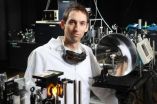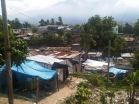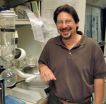(Press-News.org) Troy, N.Y. – Benjamin Clough has developed a novel method for eavesdropping on terahertz information hidden in invisible plasma acoustic bursts. The doctoral student at Rensselaer Polytechnic Institute has demonstrated a promising technique that employs sound waves to boost the distance from which researchers can use powerful terahertz technology to remotely detect hidden explosives, chemicals, and other dangerous materials.
Clough, a student in the Department of Electrical, Computer, and Systems Engineering at Rensselaer, is one of three finalists for the 2011 $30,000 Lemelson-MIT Rensselaer Student Prize. A public ceremony announcing this year's winner will be held at 7 p.m. on Wednesday, March 9 in the auditorium of the Rensselaer Center for Biotechnology and Interdisciplinary Studies. For more information on the ceremony visit: http://www.eng.rpi.edu/lemelson/
Clough's project is titled "Terahertz Enhanced Acoustics," and his faculty adviser is Xi-Cheng Zhang, the J. Erik Jonsson Professor of Science at Rensselaer and director of the university's Center for Terahertz Research.
The Rensselaer Center for Terahertz Research is one of the most active groups worldwide to apply terahertz wave technology for security and defense applications. Sensors using terahertz waves can penetrate packaging materials or clothing and identify the unique terahertz "fingerprints" of many hidden materials. Terahertz waves occupy a large segment of the electromagnetic spectrum between the infrared and microwave bands. Unlike X-rays and microwaves, terahertz radiation is very low energy and poses no known health threat to humans.
A key practical limitation of terahertz technology, however, is that it only works over short distances. Naturally occurring moisture in air absorbs terahertz waves, weakening the signal and sensing capabilities. This distance limitation is not ideal for applications in bomb or hazardous material detection, where the human operator wants to be as far away as possible from the potential threat.
Clough's patent-pending solution to this problem is a new method for using sound waves to remotely "listen" to terahertz signals from a distance. Focusing two laser beams into air creates small bursts of plasma, which in turn create terahertz pulses. Another pair of lasers is aimed near the target of interest to create a second plasma for detecting the terahertz pulses after they have interacted with the material. This detection plasma produces acoustic waves as it ionizes the air. Clough discovered that by using a sensitive microphone to "listen" to the plasma, he could detect terahertz wave information embedded in these sound waves. This audio information can then be converted into digital data and instantly checked against a library of known terahertz fingerprints, to determine the chemical composition of the mystery material.
So far, Clough has successfully demonstrated the ability to use acoustics to identify the terahertz fingerprints from several meters away. He has separately demonstrated plasma acoustic detection from 11 meters, limited only by available lab space. Along with the increased distance from the potentially hazardous material, an additional advantage is that his system does not require a direct line of sight to collect signals, as the microphone can still capture the audio information. Potential applications of Clough's invention, which circumvents the fundamental limitations of remote terahertz spectroscopy, include environmental monitoring of atmospheric conditions, monitoring smokestack emissions, inspecting suspicious packages, or even detecting land mines – all from a safe distance.
Clough has presented his findings at several international conferences, and the details of his work have been published in Optics Letters and Physical Review E. His new method for terahertz sensing has created the possibility to obtain terahertz spectroscopic information from a distance, bypassing a key limitation of high terahertz absorption by water vapor in air.
A National Science Foundation Integrative Graduate Education and Research Traineeship (IGERT) fellow, Clough is deeply committed to his research activities. He received the Rensselaer Founders Award of Excellence in 2009, as well as the Rensselaer NSF IGERT Best Presenter Award in 2010.
Hailing from Albuquerque, N.M., Clough grew up immersed in science and technology. He inherited a love of research from his father, a retired chemist, and a strong work ethic from his mother, a retired professor of nursing. Along with his parents, Clough's wife, Kara, and older sister, Sandy, are rooting for him to win the 2011 Lemelson-MIT Rensselaer Student Prize. Clough said the idea for his innovation struck him while relaxing on the beach in Mexico during a winter vacation with his family. Outside the lab and classroom, he enjoys a variety of activities including playing soccer, snowboarding, and backpacking with his wife and friends.
Clough received his bachelor's degree in electrical engineering from the University of New Mexico. He joined Rensselaer as a doctoral student in 2007.
INFORMATION:
About the $30,000 Lemelson-MIT Rensselaer Student Prize
The $30,000 Lemelson-MIT Rensselaer Student Prize is funded through a partnership with the Lemelson-MIT Program, which has awarded the $30,000 Lemelson-MIT Student Prize to outstanding student inventors at MIT since 1995.
About the Lemelson-Mit Program
Celebrating innovation, inspiring youth
The Lemelson-MIT Program celebrates outstanding innovators and inspires young people to pursue creative lives and careers through invention.
Jerome H. Lemelson, one of U.S. history's most prolific inventors, and his wife, Dorothy, founded the Lemelson-MIT Program at the Massachusetts Institute of Technology in 1994. It is funded by the Lemelson Foundation and administered by the School of Engineering. The Foundation sparks, sustains and celebrates innovation and the inventive spirit. It supports projects in the U.S. and developing countries that nurture innovators and unleash invention to advance economic, social and environmentally sustainable development. To date the Lemelson Foundation has donated or committed more than U.S. $150 million in support of its mission. http://web.mit.edu/invent/
For information on past winners of the $30,000 Lemelson-MIT Rensselaer Student Prize, visit:
Helping Hydrogen: Student Inventor Tackles Challenge of Hydrogen Storage
Javad Rafiee's graphene innovation could lead to more efficient hydrogen-powered vehicles
http://news.rpi.edu/update.do?artcenterkey=2690
Student Developer of Versatile "G-gels" Wins $30,000 Lemelson-Rensselaer Prize
Yuehua "Tony" Yu's innovation could lead to new medical devices, drug-delivery technologies
http://news.rpi.edu/update.do?artcenterkey=2538
Student Develops New LED, Wins $30,000 Lemelson-Rensselaer Prize
Martin Schubert's polarized LED could improve LCD displays, save energy
http://news.rpi.edu/update.do?artcenterkey=2406
Handheld "T-ray" Device Earns New $30,000 Lemelson-Rensselaer Student Prize
Brian Schulkin's "Mini-Z" spots cracks in space shuttle foam, detects tumors in tissue
http://news.rpi.edu/update.do?artcenterkey=1944
Contact
Michael Mullaney
Rensselaer Polytechnic Institute
Troy, NY
518-276-6161
mullam@rpi.edu
www.rpi.edu/news
Visit the Rensselaer research and discovery blog: http://approach.rpi.edu
Follow us on Twitter: www.twitter.com/RPInews
Student innovation at Rensselaer holds key to safer remote detection of dangerous materials
Benjamin Clough Is 1 of 3 finalists for the 2011 $30,000 Lemelson-MIT Rensselaer Student Prize
2011-03-01
ELSE PRESS RELEASES FROM THIS DATE:
NYU physicists develop potent packing process
2011-03-01
New York University physicists have developed a method for packing microscopic spheres that could lead to improvements in commercial products ranging from pharmaceutical lotions to ice cream. Their work, which relies on an innovative application of statistical mechanics, appears in the Proceedings of the National Academy of Sciences.
The study aimed to manipulate the properties of emulsions, which are a mixture of two or more immiscible liquids. The NYU researchers examined droplets of oil in water, which form the basis of a range of consumer products, including butter, ...
NYU researchers identify neural circuits used in processing basic linguistic phrases
2011-03-01
New York University researchers have isolated neural activity that reflects basic mechanisms used by the brain to combine elementary pieces of language in order to construct complex ideas.
The study, which appears in the Journal of Neuroscience, was conducted by Douglas Bemis, a graduate student in NYU's Department of Psychology, and Liina Pylkkänen, an associate professor in NYU's Department of Psychology and Department of Linguistics.
Researchers have long studied the neural regions that underlie the processing of complete sentences and other complex linguistic ...
Share of black S&E degrees from HBCUs declines in 2008
2011-03-01
More than 45 years after the Civil Rights Act of 1964, National Science Foundation (NSF) statistics show minority academic institutions still enroll a substantial number of minority students, but the percentage of minorities earning bachelor's degrees in science and engineering (S&E) from minority-serving institutions has declined over time.
Statistics published today in a report titled "Women, Minorities, and Persons with Disabilities in Science and Engineering: 2011" show that 26 percent of blacks earned S&E bachelor's degrees from historically black colleges and universities ...
Lead contamination in Philadelphia's Chinatown discovered by Jefferson Emergency Medicine team
2011-03-01
PHILADELPHIA – Recently, a research team from the Department of Emergency Medicine at Jefferson Medical College of Thomas Jefferson University discovered an alarming amount of lead contamination in ceramic cooking and eating utensils sold in Philadelphia's Chinatown. The team, led be Gerald O'Malley, D.O., director of Clinical Research; and Thomas Gilmore, M.D., resident, purchased and tested a sampling of Chinese ceramics. Using a LeadCheck®, one area on each item was rubbed with a lead-detecting solution. In almost 30 percent of the items, the area turned pink or red, ...
Team delivers development aid via cell phone animations
2011-03-01
CHAMPAIGN, lll. — A farmer in Niger learns how to protect his crops from insects. A resident of Port-au-Prince or a rural Haitian village learns how to avoid exposure to cholera. An entrepreneur in Mali gets step-by-step instructions on extracting the oil from shea seeds to make shea butter she can sell at a local market.
These people are benefiting from a new approach to sustainable development education that reaches a much larger audience than traditional methods – and at a fraction of the cost. The initiative, led by a team of extension educators and faculty at the ...
A grudge match between humanity and death -- who wins?
2011-03-01
FAIRFAX, Va., February 28, 2011—Death can be terrifying. Recognizing that death is inescapable and unpredictable makes us incredibly vulnerable, and can invoke feelings of anxiety, hatred and fear. But new research by George Mason University psychology professor Todd Kashdan shows that being a mindful person not only makes you generally more tolerant and less defensive, but it can also actually neutralize fears of dying and death.
"Mindfulness is being open, receptive, and attentive to whatever is unfolding in the present moment," says Kashdan. In his latest research, ...
New marker found for Sanfilippo disease
2011-03-01
Sanfilippo disease is a rare disorder caused by the failure of enzymes to break down specific kinds of complex carbohydrates, resulting in their accumulation in cells and often severe physical and neurological problems – and sometimes early death.
In a paper published in the March 4 issue of the Journal of Biological Chemistry, researchers at the University of California, San Diego School of Medicine, led by Jeffrey D. Esko, PhD, professor in the Department of Cellular and Molecular Medicine, describe the build-up of a novel secondary metabolite in Sanfilippo disease, ...
WSU researcher creates patented personalized therapy that causes cancer cells to kill themselves
2011-03-01
A Wayne State University School of Medicine physician-researcher has developed a personalized therapy to treat a wide range of cancers. The treatment is based on a naturally occurring human enzyme that has been genetically modified to fool cancer cells into killing themselves.
The unique concept, patented by Wayne State University, was successfully demonstrated on melanoma cells that are resistant to routine treatments such as chemotherapy or radiotherapy. Melanoma is a perfect model for testing this new therapy because it is considered the most aggressive form of human ...
Human stem cells from fat tissue fuse with rat heart cells and beat
2011-03-01
If Dr. Doolittle is famous for talking to animals, then here's a story that might make him hold his tongue: According to new research published online in The FASEB Journal (http://www.fasebj.org), scientists have successfully fused human stem cells derived from subcutaneous adipose (fat) tissue with muscle cells from rat hearts. Not only did these cells "talk" to form new muscle cells altogether, but they actually beat.
"Recovery of regenerative cells located in the stromal vascular fraction of a patient's own subcutaneous tissue is relatively simple and can be used for ...
University of Maryland School of Medicine study identifies genes associated with binge drinking
2011-03-01
University of Maryland School of Medicine researchers have identified two genes associated with binge drinking that may open doors to new, more effective treatments for excessive alcohol drinking. The scientists found that manipulating two receptors in the brain, GABA receptors and toll-like receptor 4 (TLR4), "caused profound reduction" of binge drinking for two weeks in rodents that had been bred and trained to drink excessively. The study was published online the week of Feb. 28 in the journal the Proceedings of the National Academy of Sciences.
About 30 percent of ...
LAST 30 PRESS RELEASES:
First Editorial of 2026: Resisting AI slop
Joint ground- and space-based observations reveal Saturn-mass rogue planet
Inheritable genetic variant offers protection against blood cancer risk and progression
Pigs settled Pacific islands alongside early human voyagers
A Coral reef’s daily pulse reshapes microbes in surrounding waters
EAST Tokamak experiments exceed plasma density limit, offering new approach to fusion ignition
Groundbreaking discovery reveals Africa’s oldest cremation pyre and complex ritual practices
First breathing ‘lung-on-chip’ developed using genetically identical cells
How people moved pigs across the Pacific
Interaction of climate change and human activity and its impact on plant diversity in Qinghai-Tibet plateau
From addressing uncertainty to national strategy: an interpretation of Professor Lim Siong Guan’s views
Clinical trials on AI language model use in digestive healthcare
Scientists improve robotic visual–inertial trajectory localization accuracy using cross-modal interaction and selection techniques
Correlation between cancer cachexia and immune-related adverse events in HCC
Human adipose tissue: a new source for functional organoids
Metro lines double as freight highways during off-peak hours, Beijing study shows
Biomedical functions and applications of nanomaterials in tumor diagnosis and treatment: perspectives from ophthalmic oncology
3D imaging unveils how passivation improves perovskite solar cell performance
Enriching framework Al sites in 8-membered rings of Cu-SSZ-39 zeolite to enhance low-temperature ammonia selective catalytic reduction performance
AI-powered RNA drug development: a new frontier in therapeutics
Decoupling the HOR enhancement on PtRu: Dynamically matching interfacial water to reaction coordinates
Sulfur isn’t poisonous when it synergistically acts with phosphine in olefins hydroformylation
URI researchers uncover molecular mechanisms behind speciation in corals
Chitin based carbon aerogel offers a cleaner way to store thermal energy
Tracing hidden sources of nitrate pollution in rapidly changing rural urban landscapes
Viruses on plastic pollution may quietly accelerate the spread of antibiotic resistance
Three UH Rainbow Babies & Children’s faculty elected to prestigious American Pediatric Society
Tunnel resilience models unveiled to aid post-earthquake recovery
Satellite communication systems: the future of 5G/6G connectivity
Space computing power networks: a new frontier for satellite technologies
[Press-News.org] Student innovation at Rensselaer holds key to safer remote detection of dangerous materialsBenjamin Clough Is 1 of 3 finalists for the 2011 $30,000 Lemelson-MIT Rensselaer Student Prize


